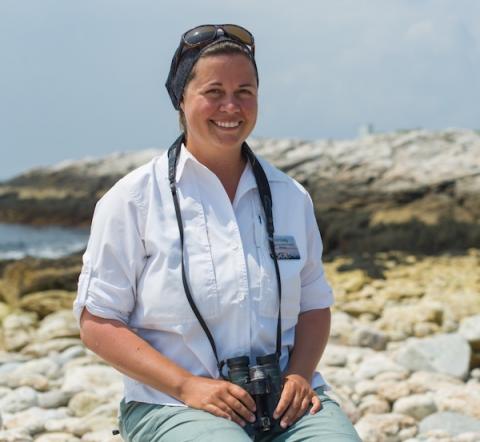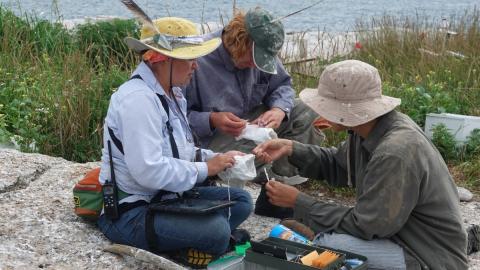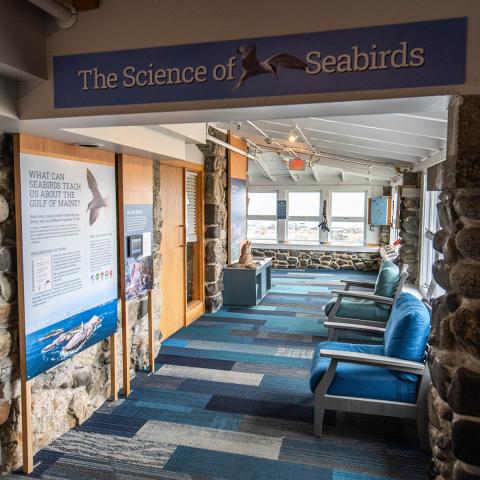Having accurate data about fish populations is vital to managing a fishery, but getting that data for younger, smaller fish using traditional sampling methods can be difficult. A research team led by Elizabeth Craig at the Shoals Marine Laboratory and the University of New Hampshire will be studying the diets of seabirds – specifically terns in the Isles of Shoals – to close this data gap and more accurately measure the health of specific fisheries. By watching what kinds of fish seabird parents feed to their chicks, analyzing fecal samples, and sampling the fish community through net tows and DNA in seawater samples, the project will inform the ways we monitor our fisheries and make management decisions.
Principle Investigator

Elizabeth Craig, Ph.D.
Director of Seabird Science, Shoals Marine Laboratory
Affiliate Faculty, Department of Biological Sciences, UNH
Contact Dr. Craig
elizabeth.craig@unh.edu
Project Funding Cycle
2020-2021 NH Sea Grant Biennial Research Funding
Co-Investigators
Nathan Furey, Ph.D.
Assistant Professor, Department of Biological Sciences, UNH
Contact Dr. Furey
nathan.furey@unh.edu
Furey Lab website
Jennifer Seavey, Ph.D.
Executive Director, Shoals Marine Laboratory
Research Faculty, School of Marine Science and Ocean Engineering, UNH
Adjunct Assistant Professor, Department of Natural Resources, Cornell University
Contact Dr. Seavey
jennifer.seavey@unh.edu
Project Abstract

The informed use and stewardship of New Hampshire’s marine resources requires a robust understanding of commercial and recreational fisheries, however, fisheries scientists and managers often lack high-quality data on young age classes of fish (0-2 years) and in inshore habitats. Seabirds have long been recognized as excellent indicators of marine health and are increasingly considered to be valuable indicators of fisheries as well, particularly for fish that are hard to sample with traditional fisheries biology methods (including the young age classes of fish in inshore waters mentioned above). Thus, there is strong potential for seabird diet to provide information necessary for proper management of coastal NH fishes. However, to reduce uncertainty of the links between seabird diet and fishery productivity, managers need to know how well seabird diet reflects the fish community, and therefore how seabirds interact with fish populations at finer spatial and temporal scales, including what characteristics seabirds select for when foraging.
Here we propose a paired sampling approach of seabird diet and fish community composition. Seabird sampling will focus on the tern nesting colony on the Isles of Shoals, NH. Terns will be GPS tagged to determine local foraging hotspot locations. Tagged terns will be visually observed while feeding their young to determine species and size of fish delivered to chicks. We will collect fecal samples from chicks and adults for genomics analysis to confirm prey items to species. Concurrently, we will deploy nets to sample the fish community (including species and size composition) and collect water samples for eDNA analysis of fish community composition at tern foraging hotspots. This research proposal is paired with an integrated environmental literacy and workforce development approach. End users of this research include state and federal fisheries and wildlife agencies (several representatives of which are included as collaborators), NH undergraduate and graduate students, and NH seacoast residents.
Expected benefits to end-users
- Evaluation of a potential tool for fisheries scientists and managers – By illuminating the relationship between tern diet and the NH inshore fish community, our research will evaluate a SBMF tool for application locally in both single-species and ecosystem-based management approaches. Furthermore, since terns breed throughout the Gulf of Maine, we foresee opportunities to apply this to SBMF efforts at a regional scale.
- Support of conservation-dependent seabird species – Our research will advance the conservation of NH’s threatened and endangered terns by improving our understanding of their prey selectivity and dietary needs, by prioritizing the inclusion of these needs into fisheries management considerations, and by advancing community awareness of seabirds and our shared reliance on NH fisheries. This provides a direct benefit to NHFG, which is charged with the management and recovery of these species.
- Advancement of workforce development and environmental literacy for the NH seacoast community - Through community engagement, along with graduate and undergraduate training, this research will advance local understand and stakeholdership in NH fisheries and wildlife.
Project News

Science of Seabirds Exhibit
Science of Seabirds Exhibit
Explore the exhibit based on Dr. Craig's previous research project at the Seacoast Science Center!

Graduate Student Feature: Linking Seabird Behavior and Fisheries
Graduate Student Feature: Linking Seabird Behavior and Fisheries
Nate Hermann studies how marine animals respond to their environment and how those responses can be used to learn about New Hampshire's fisheries.

Graduate Student Feature: Sampling Plastic Pollution and Fisheries with Seabirds
Graduate Student Feature: Sampling Plastic Pollution and Fisheries with Seabirds
Aliya Caldwell's research established a way to isolate and quantify microplastics from terns in the Isles of Shoals.